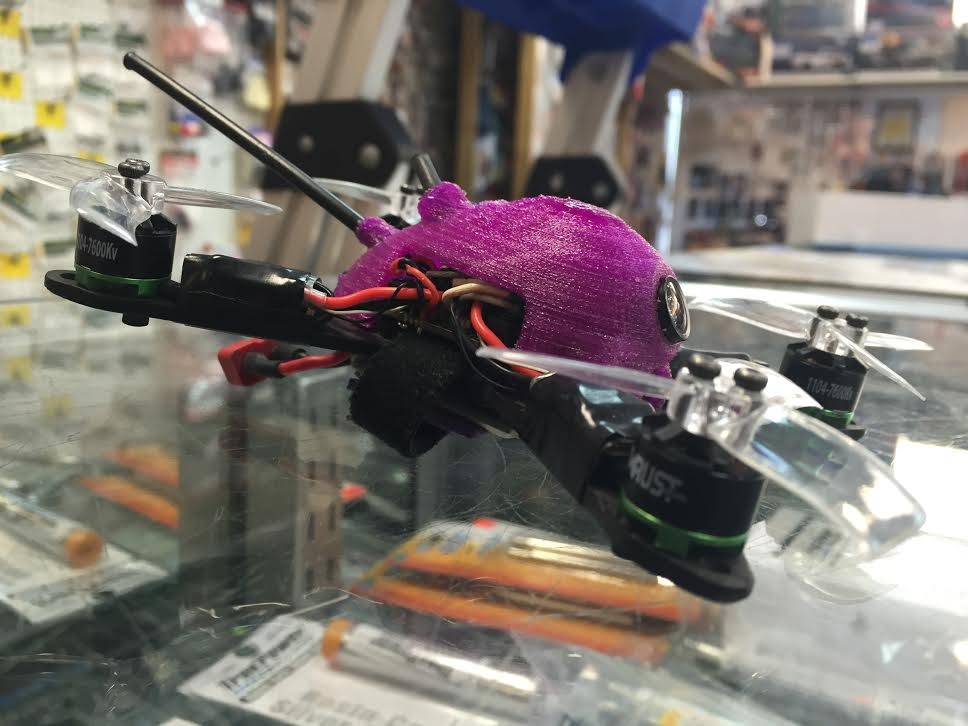
One summer evening, I was followed by a drone. The telltale whirring of its rotors gave it away, hovering above the telephone lines. There wasn’t anyone else on the road in Orange: just the flying camera and myself.
I walked one block, turned the corner, and walked another. The drone was still there. Its movements were smooth, without obvious direction or intention, and yet it remained above me. I walked another three blocks before the drone broke off. For the next three, I was looking over my shoulder.
Even if the pilot had benign or neutral intentions in flying above me, it was still unsettling to be followed by a person you cannot see, even in a public space. This is what Americans fear most about commercial unmanned aerial vehicles (UAVs, aka drones): violation of privacy. According to a Pew Research survey, 88% of Americans believe it’s important to “not have someone watch you or listen to you without your permission.” The UAVs on the market today—whose owners are often out of sight—cannot establish such permission with the people beneath its camera lens.
For Americans—especially Southern Californians—UAVs pose graver threats than peeping Toms scouring the pool decks of suburban homes. A 2016 public safety bulletin released by the California State Threat Assessment Center (STAC) claims that California accounts for nearly a quarter of the country’s unauthorized UAV encounters, with nearly half the state’s encounters happening in Los Angeles, Santa Ana, and San Diego. These encounters include a 2015 near-miss between a police helicopter along Southern California’s coast and “multiple incidents” of UAVs passing within 200 feet of passenger planes attempting to land at LAX.
Yet humble SanTana finds itself on this list nestled between California giants Los Angeles and San Diego. With a population not approaching half a million, it still surpasses San Diego (1.4 million-strong) in drone hazard reports. The reasons for the city’s place near the head of the list are unclear, though a few factors do suggest why the city has earned its position.

“Generally speaking, we tend to see a significant number of pilot drone sighting reports around airports in dense urban areas,” says Federal Aviation Authority (FAA) spokesperson Ian Gregor, “as well as airports that are in locations where the weather is good much of the year.” Santa Ana meets those conditions, John Wayne Airport surrounded not only by urban and residential areas where amateur drone enthusiasts may be concentrated. It’s also the most populous city in Orange County.
And in Santa Ana, as well as the rest of the country, drone sightings are on the rise. 2016 saw the annual total of drone reports from pilots jump to 18,000 from 12,000 the previous year. “The number of drone sighting reports we’re receiving from pilots [throughout the US] is increasing,” says Gregor. “So far this year, we’re averaging 200 pilot drone sightings per month.”
For fire-prone Southern California, the most alarming threat drones pose is their ability to obstruct firefighting operations. At least nine FAA investigations have been opened since June of 2016 looking into cases where UAVs have prevented firefighting aircraft from operating. “Unless you’re less that 30, 40 feet away, you just can’t see them,” says Mark Stone, Communications Officer for the Orange County Fire Authority. “If these drones hit our aircraft, they have the potential to damage the aircraft to the point where [it] might have to set down for emergency repairs.”
For most, though, drones are more feared as a surveillance tool than as a flight hazard. Commercial UAVs’ association with their larger military cousins is cause enough for many to fear the crafts.
“We get kicked out of places a lot,” says Taylor Lewis, drone racing enthusiast and sales associate at Ultimate Hobbies in Orange. “Because people perceive them as a threat even if they’re not. You’d be surprised at the excuses I’ve had.”
“A drone is something that shoots down airplanes,” says Amir Shoham, owner and manager of Remote Control Hobbies in Orange. “Why they call them drones…is inaccurate. As far as I’m concerned, I call them quadcopters or multicopters.”
 Despite general apprehension for UAVs, enough people have gained interest in the vehicles to take drones from a hobby good to a consumer commodity, available to pilots less aware of risks and regulations. “It’s become more of a consumer electronic item,” says Lewis, “same thing as like a smartphone, or a camera, or any of that stuff.”
Despite general apprehension for UAVs, enough people have gained interest in the vehicles to take drones from a hobby good to a consumer commodity, available to pilots less aware of risks and regulations. “It’s become more of a consumer electronic item,” says Lewis, “same thing as like a smartphone, or a camera, or any of that stuff.”
Most drone companies already account for the indiscretion of electronics consumers and build in safety features for their UAVs. It didn’t take long for consumers to learn how to hack these features, though, the way one might jailbreak an iPhone. While a consumer drone might be restricted to an altitude of 1,500 ft, an unrestricted commercial UAV might fly as high as 11,000 ft. The typical FAA altitude limit for UAVs under 55 lbs is 400 ft.
The FAA already forbids the unapproved use of aircraft near airports and in areas of high air traffic: one of the reasons that Southern California cities like Los Angeles, Santa Ana, and San Diego have so many drone violations. In the past two years, though, Orange County’s city halls inked dozens of new drone-specific laws and regulations in response to the vehicles’ increasing omnipresence. Laguna Beach, Huntington Beach, and Dana Point are the latest targets of regulation, forbidding drones from many of the cities’ scenic parks and beaches. Though the laws are often redundant, this fist-shaking is all they have to ward off the perceived sky-borne menace.

